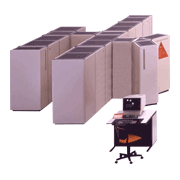This was Hitachi's first supercomputer, anounced in August 1982. It employed parallel pipeline arithmetic processing, with multiple computing elements operating in parallel, and thus had the world's fastest capacity -- performing 630 million operations per second. It also subsumed the M Series architecture, and therefore ensured the same ease-of-use as previous general-purpose systems, with features like a TSS function and center function. It was widely used by users at the leading edge of progress in science and technology, primarily research institutions. The first machine was shipped to the University of Tokyo Large Computer Center in October 1983.
The series was comprised of the entry model S-810/5, a higher-end model called the S-810/10, and a top-end model, the S-810/20. Upgrading to higher end models could be done easily, on-site.
| S-810/5 | S-810/10 | S-810/20 | ||
|---|---|---|---|---|
| Max. performance | 160MFLOPS | 315MFLOPS | 630MFLOPS | |
| Number of vector instructions | 80 | 83 | ||
| Vector registers | 256words x 16 | 256wordsx32 | ||
| Vector mask register | 256words x 8 | |||
| Scalar register | 16 | 32 | ||
| Vector address register | 48 | |||
| Buffer memory | 256KB | |||
| Main memory capacity | 32-128MB | 64-256MB | ||
| Expansion memory | Capacity | 256-1,536MB or 256-3,072MB | ||
| Maximum transfer speed | 500MB/sec or 1,000MB/sec | |||
| Number of channels | 8-32 | |||


